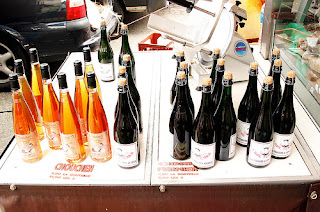from
Behind the French Menu
by
Bryan G. Newman
behindthefrenchmenu@gmail.com
Chouchen
Chouchen and the
Druids.
Originally only drunk by the Celtic priests,
the Druids, Chouchen is an alcoholic mead made with fermented honey, a hydromel.
The recipe was brought from Britain by
the British Celts who crossed the English Channel to the most westerly part of
mainland France, along with their priests over a period of over 900 years.
The
Celts had left Britain in waves to escape the invading Romans who had arrived in
50 BCE followed by the Germanic tribes of Angles and Saxons who came when the
Romans left around 410 CE; that gave the inhabitants of Britain the name
Anglo-Saxon, Then in 793 CE came the Vikings followed by the arrival of William
the Conqueror, himself a descendant of the Vikings, in 1066. The Celts meanwhile
had claimed a large part of modern France’s Atlantic coast and called their new
home Bretagne (Britain) I can imagine
that they also enjoyed a glass or two of their Chouchen to brighten their first evening in a foreign land.
Plymouth, Great
Britain to Roscoff. Brittany.
Approximately 215 km
(134 miles)
Photograph courtesy
of Google Maps.
Dining when Chouchen is on the menu:
Loup de Mer Rôti, Aromatisé à la Moutarde de Truffe, Crème au Chouchen - Roasted sea
bass, flavored with mustard
accented truffles and a Chouchen cream sauce.
Chouchen and Brittany
Cider.
Noix de Pétoncle en Coquille, Gratinées au Chouchen – The meat of the queen scallop (queenies) served on the half shell lightly
browned and flavored with chouchen.
Onglet de Veau au Pralin de Chouchen à l'Échalotes – A veal flank steak prepared with a pralin like preparation made from caramelized almonds or hazelnuts flavored with Chouchen and shallots.
Druid Festival - SAMAÏN FEST
www.flickr.com/photos/21753643@N08/6319144863/
The different
varieties of Chouchen.
The wine shops of today’s Brittany offer Chouchen
in a wide variety of flavors. The original differences were explained by the
different honeys used and those are still available today; however, some
versions are flavored with fruit juices and or wines. Whatever the style that
is being offered Chouchen may be on your menu as an apéritif when
it is best when served chilled or part of a sauce or flavoring on the entrée,
the French first course, through the
dessert. The original fermented honey had, at most, 8% alcohol today’s
higher level is arrived at through distillation usually with apple juice and
sold with 14% to 16.5% alcohol,
Among the locals, Chouchen is no
longer as popular as Brittany’s famous ciders,
probably because it is more expensive. Nevertheless, Chouchen will be
in many local recipes, old and new, and it will be in all the wine shops.
The Bollée
Chouchen was traditionally served in a
small cup with a handle; that cup is called a Bollée and it looks something like a small teacup. Today, in the café or restaurant you visit
that cup may well have been replaced by a regular glass. Nevertheless, if you are visiting a cafe or restaurant
where they keep to the old traditions do not be surprised when a small cup,
that holds around 200ml of Chouchen, is placed on your table. That is a Chouchen
Bollée and you will know what it is for.
In Brittany
celebrations will have oysters at the center
They will be
accompanied by cidre bouché, or chouchen, not champagne.
Mid-Summer Night
with the Druids
The good citizens of Bretagne are proud
of their Celtic and Druid heritage and on the 21st of June every year, mid-summer night,
the summer solstice, and the day before, and sometimes for a few days
after many communities will be celebrating their Druid ancestry; visitors
welcome.
The celebrations include many local
variations along with a great deal of food, cider, lambig, their apple brandy,
and, of course, chouchen. Call the nearest French Government Tourism Office and you
may experience a mid-summer day and night very different to Shakespeare's
Mid-Summer Night’s Dream. The English website for the Brittany Tourism office
is:
Before Bretagne the
area was Amor
And then the Romans
came.
As you drive around Bretagne you will see
many place names and business names that include the words Amor, Amorica,
Armorique and similar; this is all part of Bretagne's history. Amor was the ancient name for Bretagne before
the British Celts came; then came the Romans under Julius Caesar and he changed
the name to Amorica. The largest national park in Bretagne is called the Parc
Naturel Régional d'Armorique, the natural regional Park of Armorique.
Amor and Amorica have nothing to do with
America. America's two continents are
named after Amerigo Vespucci (1454 – February 22, 1512) the Italian explorer
who was the first to show that the two American continents were not part of
Columbus’s India. Though he never made
it to North America his name is still honored on both continents.
Remember, it was the British Celts through
their various immigrations that founded Brittany and so if you want really good
British food and drink go to Brittany! In 1532 Bretagne, Brittany became part
of France.
-----------------------------------
Behind the French Menu
by
Bryan G. Newman
behindthefrenchmenu@gmail.com
Copyright 2010, 2014,
2017, 2019
---------------------------
Searching for the
meaning of words, names or phrases
on
French menus?
Just add the word, words, or phrase that
you are searching for to the words "Behind the French Menu" (best
when including the inverted commas), and search with Google or Bing, Behind
the French Menu’s links include hundreds of words, names, and phrases that are
seen on French menus. There are over 450 articles that include over 4,000
French dishes with English translations and explanations.
Connected Posts:


















